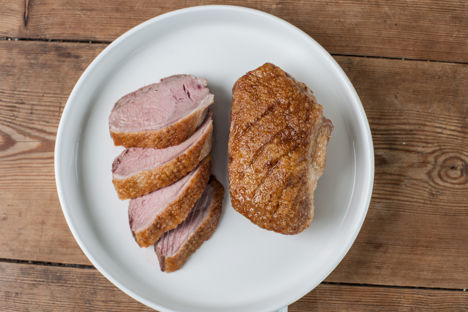A duck is a creature which evokes a wide range of tastes and associations. There's the convenience of a mid-week duck salad, or the enduring ceremony of an elaborate five bird roast. And there remain exotic associations with France's canard: duck confit, foie gras, cassoulets, ballotines and rillettes. A duck breast might be smoked, a duck leg might be cooked confit, or the bird could be turned into duck dodine – boned and stuffed with more duck. Dependent on the skill and imagination of the chef, the possibilities are infinite.
What to look for when buying duck
When buying a wild duck, look for supple skin, plump breasts and a flexible beak. Ducks should be consumed within three days of killing – unlike other game they shouldn't be hung for too long, as the fat goes rancid. Be aware of this when buying ducks, particularly in the new year which is towards the end of the season.
How to cook duck
Duck unnecessarily incites fear in a lot of home cooks, but as long as you avoid drying out a whole bird by blasting it in the oven, then there really is little scope for error.
Pan-frying duck breasts is a great place to start – and will quickly boost confidence as a spectacular meal can be created with very little effort.
Young and tender birds can be roasted on a spit or in an oven, so that the meat is still pale and pink. For inspiration, see Macello Tully's recipe, for a 2kg duck which he roasts for half an hour at 220˚C, then turning down the oven to 170˚C for a further 1 hour 10 minutes. When roasting duck, it is important to prepare it properly, ensuring that the giblets have been removed and that the skin has been pricked all over to allow the fat to render during the cooking process.
Older birds can also be roasted, but it's often best to braise them so that they don't dry out, and so that the strongly-flavoured meat can be balanced with other flavours in the sauce. For inspiration, see Dominic Chapman's recipe, for braised duck leg which allows it to slowly cook in chicken stock at 160˚C for 1–2 hours. As well as a classic cassoulet (see Simon Hulstone's spectacular duck and hog's pudding cassoulet). Duck also makes a delicious ragu, and can also be hot-smoked in a home-smoker.
With duck being a classic ingredient in traditional French cooking, it's unsurprising that there are so many techniques involving the bird. Confiting a duck leg is a lengthy but enormously enjoyable process. From James Mackenzie's five bird roast to Pascal Aussignac's duck pot-au-feu, to salmis, ballotines and rillettes there is a whole host of exciting ways to slow-cook a duck.
The quickest method of 'cooking' duck is not to do so at all. A breast can be sliced very thinly and served raw, in carpaccio form.
Pan-frying the duck breast still makes for a speedy supper. We have put together an entire duck breast collection, which detail the small differences in different chefs' methods. The simplest method starts off by frying the duck skin-side down in a dry pan. The layer of fat beneath the skin will quickly melt, meaning that neither butter nor oil is necessary. After 2–3 minutes, flip the duck breast over and briefly fry the other side, then put the pan inside a hot oven for a further 5 minutes. The skin should have turned golden and crispy, while the flesh will still be pink and moist. Allow the breast to rest for a further 5 minutes before slicing and serving.
What duck goes with
As with most game animals, a good place to start when thinking of what flavours to pair duck with is to consider what the omnivorous birds might eat in the wild: grain, berries, grasses and other greens. For inspiration, see James McKenzie's smoked mallard salad which is served with a cranberry relish, or Adam Stokes' duck breast recipe, accompanied with walnuts and rhubarb.
Duck is a strongly-flavoured meat, so can handle other strong flavours. A common pairing is orange which cuts through the richness, as with the orange, pine kernels and dandelion in Adam Stokes' duck salad. Another big flavour often paired with duck is mushroom. The mushrooms could be used as a dramatic garnish as with Nuno Mendes's duck heart recipe, or in a sauce which underpins each mouthful, as with Pascal Aussignac's crackling duck pie.
Ducks were first bred in China, and they remain a popular dish in East Asia. Peking duck is still one of the country's most famous culinary exports, coating the duck in a sweet sauce like hoisin. But duck works well alongside other traditional ingredients like honey and soy, ginger, Szechuan peppercorns and is often used as a stuffing inside spring rolls.
Of course, there is no need to force spice into a duck recipe. The meat is flavoursome enough that slivers of duck meat are treat-enough left raw in carpaccio form, or served between two slices of bread as a gourmet sandwich. Another easy way of thinking of duck is in 'meat 'n veg' terms – for inspiration see Josh Eggleton's duck breast with chicory and potato dauphinoise or Dominic Chapman's braised duck leg with sweet young peas, lettuce, bacon and mint.
Get in touch
Please sign in or register to send a comment to Great British Chefs.



